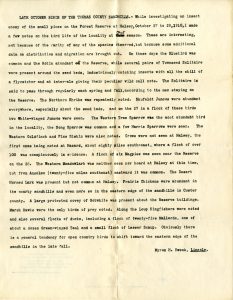Great Nebraska
Naturalists and ScientistsNOU, Myron Swenk, Field Notes, undated
 371-00012
371-00012
LATE OCTOBER BIRDS OF THE THOMAS COUNTY SANDHILLS. – While investigating an insect enemy of the small pines on the Forest Reserve at Halsey, October 27 to 29, 1910, I made a few notes on the bird life of the locality at that season. These are interesting, not because of the rarity of any of the species observed, but because some additional data on distribution and migration are brought out. On these days the Bluebird was common and the Robin abundant at the Reserve, while several pairs of Townsend Solitaire were present around the seed beds, industriously catching insects with all the skill of a flycatcher and at intervals giving their peculiar wild call note. The Solitaire is said to pass through regularly each spring and fall, according to the men staying on the Reserve. The Northern Shrike was repeatedly noted. Shufoldt Juncos were abundant everywhere, especially about the seed beds, and on the 27 in a flock of these birds two White-winged Juncos were seen. The Western Tree Sparrow was the most abundant bird in the locality, the Song Sparrow was common and a few Harris Sparrows were seen. The Western Goldfinch and Pine Siskin were also noted. Crows were not seen at Halsey, the first ones being noted at Hazard, about eighty miles south-east, where a flock of over 100 was conspicuously in evidence. A flock of six Magpies was seen near the Reserve on the 28. The Western Meadowlark was neither seen nor heard at Halsey at this time, but from Anselmo (twenty-five miles southeast) eastward it was common. The Desert Horned Lark was present but not common at Halsey. Prairie Chickens were abundant in the nearby sandhills and even more so in the eastern edge of the sandhills in Custer county. A large protected covey of Bobwhite was present about the Reserve buildings. Marsh Hawks were the only birds of prey noted. Along the Loup Kingfishers were noted and also several flocks of ducks, including a flock of twenty-five Mallards, one of about a dozen Green-winged Teal and a small flock of Lesser Scaup. Obviously there is a general tendency for open country birds to shift toward the eastern edge of the sandhills in the late fall.
Myron H. Swenk, Lincoln